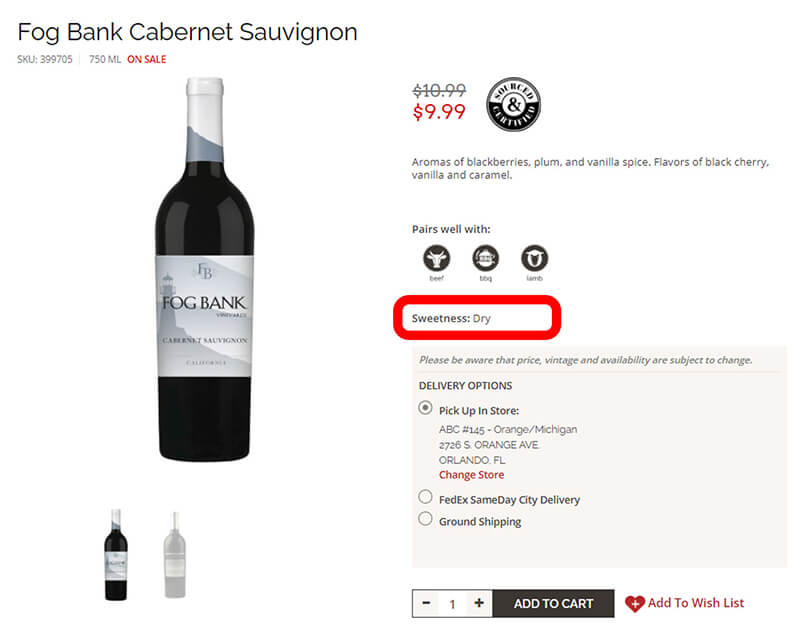An Easy Lesson on Wine Terminology

By Marie Gorbenko Published December 2021
Vintage, varietal, vinification – oh my! Have you ever come across wine terms that are a little confusing? Not to worry. This article will give you a glossary of some frequently used industry terms unpacked in newbie-friendly language. You will be toasting with all the right terminology in no time.
Body
A common term associated with wine is the “body.” But what does that mean? Generally, you will hear people refer to, or categorize wines, as light, medium, or full-bodied. The “body” of the wine refers to the drinker’s experience with the wine on the palate, more so than the flavor or aroma of the wine. Alcohol content is the biggest textural component in wine. Therefore, a wine with a higher alcohol content tends to be more full-bodied as it’s a textural component that is heavier and denser on the palate and on the finish. Meanwhile, a light-bodied wine has less weight and density on the tongue and is light on the palate. The body is also one of the most important things to consider while pairing wine with food.
Sweetness
Sweet as a wine term may seem self-explanatory. Sweetness is not necessarily sugary sweet or sour—it’s more of a grade of sugar content and residual sugars on the finish. People aren’t always sure where that sweetness comes from, but it really comes from the grape and how long the bunches ripen on the vine. The sweetness of a wine is another major contributing factor to the texture of the wine—a lot like the alcohol content—so it does play a role in the body as well as in flavor. Depending on the method and length of fermentation, you can get wines that have more or less sugar on the palate. A dry wine has less sugar while a sweet wine obviously has more sugar. And if you’re ever wondering how sweet or dry a wine is, just refer to the item’s page online at abcfws.com (example below) or the product’s shelf tag at your local ABC. They’ll tell you everything you need to know.

Tannins
Tannins are another important component of wine; especially red wine, though technically they exist in all kinds of varietals. Tannins are a form of acid that comes from grape skins, stems and seeds. The thicker the grape skins, the more tannin you’re going to experience on your palate. Most of us experience tannins in something like black tea, when we taste a strong and sharp flavor. In red wines, tannins tend to hit you on the sides and top of the mouth, whereas regular fruit acid tends to hit you more on the center of the tongue. Wines with heavy tannins often have more longevity for aging potential. As wine ages the tannins soften or precipitate out of the wine and fall as sediment in the bottle.
Some people feel that heavy tannic wines tend to give them headaches. This can happen because red wines more often set off histamine reactions as opposed to white wines, which usually is the cause of headaches. Some people believe that it’s sulfites that set off this reaction, but technically there are more sulfites in potato chips and dried fruit. So, if you don’t get headaches from those, you’re not getting headaches from the sulfites in your wine.
Sulfites
Sulfites develop naturally during the fermentation stage of winemaking. All wines—organic, kosher, non-organic—have sulfites as they are a by-product of fermentation. To get no detectable sulfites, you must go through a secondary chemical process to remove them. Sulfites are chemical molecules that exist naturally in grape skins and seeds - which is one explanation of how they get into the fermented wine. They were also used in the historical fermentation process to stabilize wine. This process doesn’t occur nearly as often due to modern refrigeration, which does the same thing.
Complexity
How do I know if a wine is complex or not? It’s complicated. Frankly, there are so many different elements considered when discussing if a wine is complex or not, but it all comes down to layers of flavor. You get an original experience with first sips and then as you go back to the glass again and again, you’ll find a different experience each time—that’s what really shows complexity.
There are certain things that winemakers can do to help layer the complexity in a wine. One of them is how long the grapes sit on their skins, which is otherwise known as “lees.” They use a tool to pump the wine over and it extracts solid particles from the skins (even in white wines, since they exist in all grapes) - this helps add a creaminess to the texture of wine that wouldn’t exist otherwise.
When wines—both red and white—are aged in oak barrels, not only does this add tannin from the oak, but it also micro oxidizes the wine (which in a way condenses the liquids in it and makes the flavors more complex because they’re denser) and adds a broader textural component to the wine as well. Usually, wines that have a little more tannin tend to be a more complex.
Varietal
Varietal really just means the type of grape. The confusion regarding this term mostly arises out of the differences between Old and New World wine talk. In the Old World, they generally talk about their wines by region and would describe a wine by calling it a Burgundy or a Bordeaux. In the New World, we tend to describe our wines by varietal, by the grape type, because we plant all kinds of varietals everywhere. This is because you can’t just say “Sonoma red” and know that that wine is going to be cabernet sauvignon, pinot noir, zinfandel, or any of the other red grapes grown in Sonoma.
Vintage
Vintage refers to the year the grapes were harvested, not necessarily the year the grapes went into the bottle. There are many wines that are non-vintage, which means they are a blend of grapes grown from more than one year.
Legs
Legs occur when the alcohol evaporates from the glycerin in wine. Legs in wine are sometimes actually called “cathedral windows” because the shape they make reminds us of a gothic cathedral window. We’ve already talked about how alcohol content affects body and texture—this is also one of the main components in legs.
Legs occur in wine because alcohol, water and glycerin all evaporate at different rates with alcohol evaporating the quickest. As you’re swirling your glass, that alcohol is evaporating; and therefore, the water and glycerin group together to create those distinctive sheets. Wines that also have higher sugar and alcohol levels are going to produce more profound and distinguishable legs on your glass.
Curious about learning even more wine jargon? Visit an ABC location near you, where our wine consultants can answer all of your wine-related questions. We pride ourselves on our extensive wine knowledge and seek to make it more accessible for everyone.



